Garden borders: 25 ideas for the perfect planting scheme
Garden borders 25 ideas for theme, garden borders 25 ideas for the smoker, garden borders 25 ideas for the 12, brick garden borders, rock garden borders, garden borders 25 blue, cheap garden borders, garden borders 25 ideas for the perfect planting schemes, garden borders ideas, garden borders 25 ideas for elf.
Garden borders performed infinite opportunities for imaginative planting and are central to a crashed garden design. And, with a bit of know-how, you can keep your garden borders looking shimmering year-round, even in the depth of winter.
Whether you like a landscaped, formal look, or would like to create a natural garden, follow these tips from horticulturalist Matt James and manufacture luscious, thriving garden borders. Just grab your best gardening tools, and you're good to go.
1. Work with your garden's natural layout
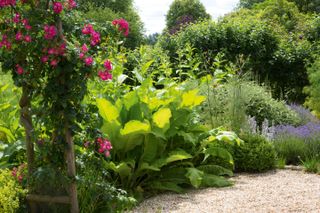
(Image credit: Leigh Clapp)
Working in harmony with your garden is always best. Garden plant ideas work when grown where they're happiest – which will also mean they'll need less attention and will both flowerbed and fruit better.
See Also: How To Follow Low Carb Diet Tips For
Working in harmony with your garden is always best. Garden plant ideas work when grown where they're happiest – which will also mean they'll need less attention and will both flowerbed and fruit better.
Spend time noting the characteristics of your beds and borders: are they sunny or shady? Wet or dry? Sheltered or exposed? Chances are you'll find different growing words in different parts of the garden. Look carefully, and then settle appropriate plants to match each one.
- Find more glorious garden ideas in our feature full of glorious borders, planting tips and more ways to use your outside space
2. Plan your planting scheme carefully
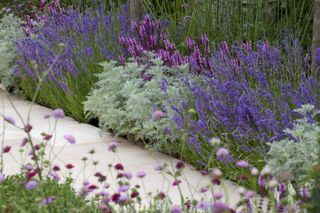
(Image credit: Leigh Clapp)
All good gardeners make their mistakes on paper, not on the ground, saving both time and wealth in the process. Use graph paper and draw on the conscription of the area to be planted, preferably to scale (1cm on paper to 50cm on the deceptive –1:50 scale – is ideal for all but the most engaged schemes). Then, considering the scale you've selected, play with different arrangements pending you find one that works. Plot plants with their archaic size in mind to be sure they'll fit.
3. Research and find inspiration
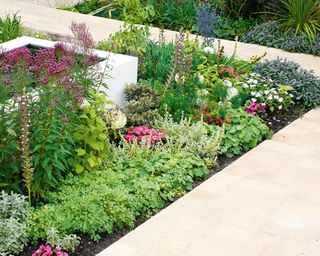
Planting beds surround this raised soak feature with rendered walls designed by Ann Marie Powell and built by Garden House Design . The colourful planting is planned to develop and mature to soften the harder lines
(Image credit: Ann Marie Powell/Garden House Design)
Find combinations you like, look in books and magazines, and if growing conditions are the same as those in your garden, copy them. Neighboring gardens and labeled displays at nurseries are also useful for ideas.
4. Consider maintenance carefully

(Image credit: Leigh Clapp)
How much time do you have? For young families and those at work all day, winter and summer bedding, rose bushes, fruit, vegetables and floppy perennials are too time-consuming.
If you're dinky on gardening time, instead favor shrubs, tidy conifers, ornamental grasses and tough-but-colourful mat-forming perennials such as Stachys Byzantina 'Silver Carpet'. All need little attention once established, and suffer few pests or diseases.
5. Choose a planting theme for your garden borders
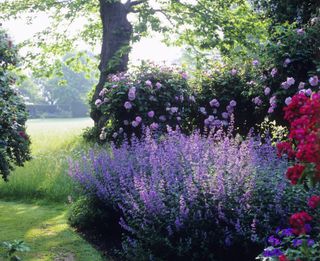
(Image credit: Leigh Clapp)
Picking a theme brings clarity and focus to the acquire process. Personal taste and how you plan to use the garden have an achieve, but the space itself can offer clues as to what works best. For example, a sunny free-draining slope is perfect for an informal Mediterranean-inspired gravel garden. Visually, it won't look out of place either.
6. Keep the border planting scheme simple
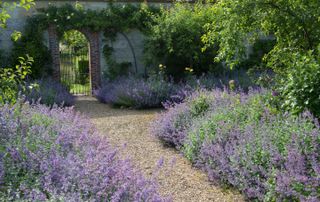
(Image credit: Leigh Clapp)
Hold yourself back from incorporating every plant on your shortlist, as the planting will look chaotic and unplanned. Aim to create a sense of harmony and people by choosing a color palette or theme early on.
7. Repeat planting in a border for a designed effect
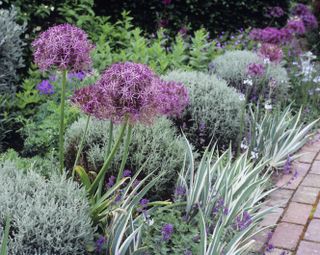
(Image credit: Leigh Clapp)
Repetition in garden borders is the easiest way to unify a planting map. It's also the one thing that marks out a 'designed' frontier, from one that happens by accident. Perhaps use the same hedging ended or repeat evergreen perennials, or ornamental grasses in drifts at the clue of beds and borders (where repetition is most obvious).
8. Use a variety of plants to create contrast
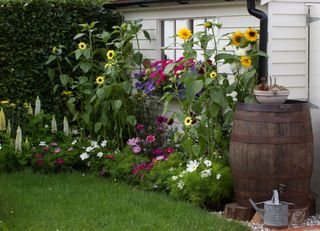
(Image credit: Leigh Clapp)
While harmony is important, so is diversity. Plants with distinctive colors and dramatic shapes, such as spiky palms and pencil junipers, make colossal focal points. But a little goes a long way, so use sparingly or the planting will look over-stimulating. With standard-sized borders (1.5-2m wide) one focal point plant every four to six metres must be enough.
A lot of space to cover? A tree frontier would work, but again, less is more with tree borders – choose one or two species for a launch. Shade gardens also prove that it's important to establish plants where they will thrive the most.
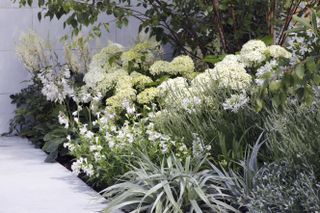
(Image credit: Leigh Clapp)
Color is a personal preference, but if you want to be more precise near it and create memorable plantings like the professionals, determine a classic combination, taking into account the color wheel. Colors opposite each other complement through dramatic contrast. Those adjacent are harmonious, and the easiest way to combine color over a colossal area.
You could pick the shades, tints and tones of one sparkling only for a sophisticated monochromatic look. Or alternatively, determine an exciting triadic combination using three colors from the wheel, each spaced equidistantly apart. A multicolored scheme is also a possibility, but isn't that easy to pull off successfully.

(Image credit: Shutterstock)
The easiest and most visually effective way to scheme plants is in layers, with borders backed by walls or fences, tall shrubs, tree borders, bamboo and lofty grasses qualified. Place roses, smaller shrubs, mid-sized perennials and ornamental grasses in the middle. Feature shorter shrubs, mounding perennials and ankle-high ground-cover plants in front.
However, try to avoid arranging everything like a series of steps. On occasion sweep low plantings towards the back, and taller ones to the principal, to create depth and interest.
11. Make big garden borders
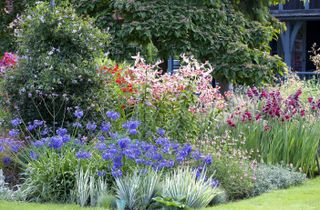
(Image credit: Leigh Clapp)
Thin strips thought 50cm wide will only allow for a low hedge, a wall shrub, or a line of tidy perennials ordered uncomfortably like soldiers on parade. Beds and borders in excess of two metres, however, can accommodate multi-layered mixed plantings with shrubs, roses and more natural drifts of perennials and grasses.
Some designs, naturalistic 'prairie-like' plantings in particular, need lots of spot for the effect to be appreciated. In small gardens this noteworthy mean sacrificing lawn space – consider if you want to do this.
12. Create mixed borders in urban gardens

(Image credit: Suzie Gibbons)
In urban and suburban gardens, continuity of interest is important. The mixed border is best, as you can call on every plant company – trees, shrubs, roses, perennials, and bulbs – for tiring„ tiresome, with each group sparkling at different times of the year.

(Image credit: Leigh Clapp)
Plants with fiery autumn leaves, stunning seed heads, colorful fruits and berries, brilliant bark or evergreen leaves prolong seasonal dead and help to lift the spirits on drab days. When planning your garden borders, remember to consider seasons other than the summer!
14. Focus on shapes to add interest to garden borders

(Image credit: Leigh Clapp)
The elegant of plants is just as important as flower vivid, and because it's around for much longer (with woody plants, all year round), shape helps to structure the planting. The color and texture will then supply the finish.
15. Line path borders with bags of bulbs

(Image credit: Future / Kasia Fiszer)
Brilliant for seasonal monotonous in spring, summer and autumn, most bulbs cope with competition so can be planted to grow above frothy perennials, giving you two colour bursts from the same do – ideal where space is tight. Only large-flowered tulips need replacing each year.
16. Add volume with shrubs
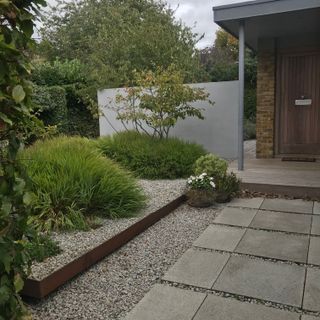
(Image credit: Lucy Willcox Garden Design)
Offering year-round monotonous for little effort, shrubs bring all-important 'body' to your borders, too. As a guide, most mixed plantings should absorb at least 40 per cent, spaced evenly throughout the demonstrate, from the back right down to the front.
Evergreens with good form and radiant leaves should be first choice, especially in small spaces. Consider size at maturity carefully, though, as some shrubs can grow to repulsive proportions.
- If big plants are your unsheaattracting, explore how to make an impact with mature plants
17. Cover all soil with plants
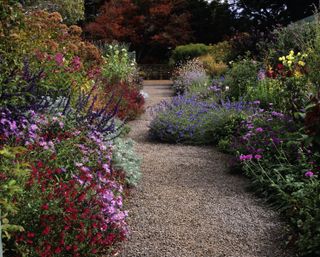
(Image credit: Future)
Plant plenty of ground-cover perennials and mat-forming shrubs to smother the soil and keep down weeds. But, don't cram plants in cheek-by-jowl for an binary effect. Observe the correct spacing (your garden centre or nursery will help here), or be prepared to undertake some judicious pruning in a few years' time.
18. The more the merrier in garden borders
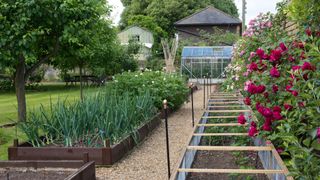
(Image credit: Leigh Clapp)
Never effect each plant as a solitary specimen. This results in a bitty-looking reveal. Instead, plant in groups proportionate to the size of space.
In itsy-bitsy gardens/borders, shrubs and roses planted in groups of three is favorite, unless they're larger specimens, where one by itself is fine. For perennials and grasses, plant in groups of three to 12 plants, depending on the importance of the plant and how distinctive it is; some plants – particularly pastel-colored single-stemmed perennials, for example – are invisible by themselves.
19. Think vertical when planting borders

(Image credit: Leigh Clapp)
Height is important for listless, contrast and to pull the eye skyward. Fastigiate (pencil-like) shrubs and climbers resbound on wigwams are ideal. Take full advantage of walls and fences, too, perhaps combining tidy non-invasive climbers that flower at different times to prolong the season of listless. Roses and large-flowered summer clematis is a classic combination.
20. Fill garden borders with scented plants

(Image credit: Leigh Clapp)
Scented plants enliven any garden, so try to include them when possible. There are so many different ones to settle from, but how powerful the perfume is will choose where they work best.
'Free scents', such as Dutch honeysuckle and white jasmine, perfume the air for yards and are generous, sometimes to a sinister. 'Up close and personal' scents, such as from roses, witch hazel and Daphne, are more subtle, so set near areas you use the most. 'Touchy-feely' scents, such as from thyme, are released only when the plant's leaves are picked; set in patio pots or next to paths, within easy reach.
21. Mix flowers and grasses in garden borders
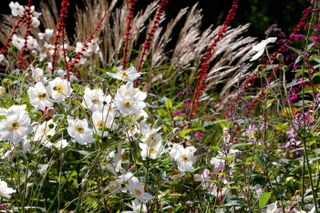
(Image credit: Leigh Clapp Photography)
For a natural, free-flowing look, grasses make a great addition to garden borders that need bulking up. From the feeble Pampas grass to the delicate and wispy Stipa, mix them with flowers such as anemone and phlox for an effortless look.
22. Add a tropical palm tree to your garden borders
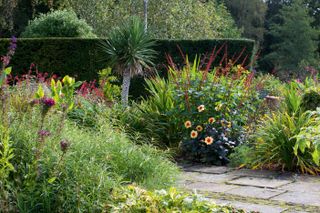
(Image credit: Leigh Clapp Photography )
Break up a feeble garden border with an exotic palm tree for a more contemporary look. Fan palms, cotton palms (Washingtonias) and needle palms all tend to do well in milder climates.
23. Use lawn edging to create a formal look for borders
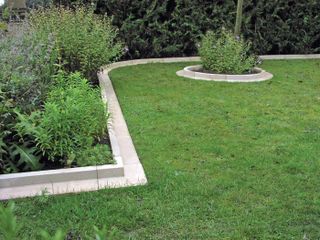
(Image credit: Haddonstone)
Lawn edging can help obtain a formal look for your garden borders and zone your garden; it will also defending your border when you mow your lawn. There are tons of materials and styles to resolve from, and what you choose will largely reflect your effort and your garden's style.
24. Garden border ideas for autumn: top plants

(Image credit: Unsplash/Rosario Janza)
Autumn presents many garden touch ideas that are colorful and will keep you garden looking tremendous well into December. Asters are the stars of the autumn garden, with many varieties blooming well into late October and sometimes November, if it's mild. Michaelmas daisies are a particularly popular variety, coming in wonderful shades of purple or dark pink. Combine them with wispy grasses and evergreen shrubs for a radiant late-season display.

(Image credit: Unsplash/Linus Mimietz)
Another autumn classic that is sometimes unfairly neglected is heather. Heather is a hardy, native plants that can did plenty of interest throughout the colder months. Choose one of the Calluna vulgaris 'Garden Girls' varieties for curious spikes of color well into January. Heathers do obliged a sunny position, though.

(Image credit: Unsplash/Dalal Nizam)
25. Liven up a north-facing garden with a tree border

(Image credit: Thompson & Morgan)
Have a north-facing garden edge that's not doing much? North-facing walls can look punitive, but it's actually relatively easy to bring a shady garden edge to life. Consider a layered planting scheme with a tree edge at the back (choose shade-tolerant trees and shrubs such as yew and skimmia), and a textured display of shade-loving ferns at the front.


Comments
Post a Comment